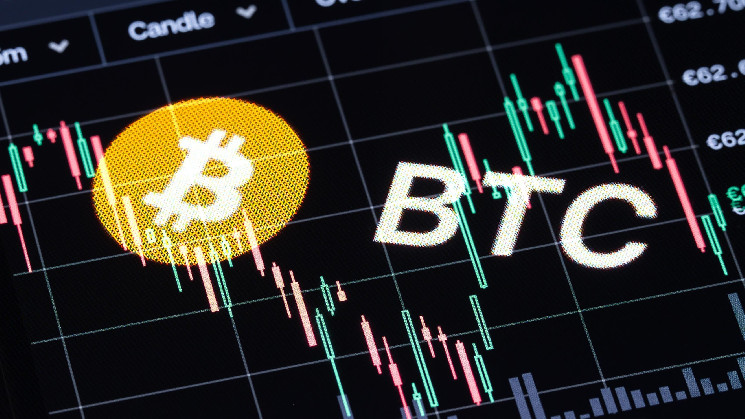Even people who know very little about bitcoin know that its price fluctuates wildly. The volatility started early. From April to June 2011, the price jumped 3000% from $0.80 to $26.35. By October, it was back down to $2.50, a 90% drop. While these are some of the highest short-term fluctuations, bitcoin remains volatile. From January to March of this year, the price nearly doubled, from $39,000 to $73,000. Today it sits at $64,318. Within 24-hour periods, bitcoin still occasionally rises or drops 10%.
Some say that bitcoin’s volatility is a function of its youthfulness. As bitcoin persists, the story goes, its volatility will level off. Everyone will have heard of it, know the costs and benefits, and will have made a decision about whether to use it or not. Right now bitcoin is in price discovery mode, and when the price is discovered, that will be the end of the volatility.
But there is no guarantee of this. Since the beginning of the year, the price of gold has risen 28%, from $2,000 on 14 February to $2,663 on 24 September. Gold has been around for millenia, and yet retains some degree of volatility.
So, it’s not purely being new that makes an asset volatile. One obvious reason for gold’s volatility is that demand fluctuates. For normal goods, when demand goes up, supply goes up too. From 2010, Apple went from producing 40 million iPhones each year to producing over 200 million in 2024. If they’d kept the supply at 40 million per year, the price would have gone up, as the 200 million people who wanted iPhones would have competed to purchase the scarce supply. The supply of new gold almost certainly cannot increase by 500% in a decade, because it resides in the ground and the process for getting it out won’t allow for such increases in discovery or extraction. So, when demand for gold increases, so does the price.
Bitcoin
Like gold, the value of bitcoin fluctuates. Like gold, when the value of bitcoin goes up, it makes sense to dedicate more resources to mining. But like gold, the Bitcoin network resists linear correlation between an increase in resources expended in mining and an increase in production. In the case of gold, this is due to the physical limitations of mining. In the case of Bitcoin, it’s due to the code – in particular, the difficulty adjustment.
The Bitcoin network has an algorithm governing block production; the target is one block every ten minutes. Every 2016 blocks, the difficulty of the math problem changes. The algorithm looks at how long the previous 2016 blocks took to mine. The ideal is two weeks. If the past 2016 blocks took less than two weeks, the math problem gets harder. If they take more than two weeks, the math problem gets easier. So, when the price of bitcoin goes up, miners can turn on more machines and use more electricity and reap more rewards. But that will make the blocks come faster, and will give them at most two weeks of faster block production. After that, the difficulty will adjust and the supply schedule will resume as normal.
This fixed supply schedule means that the price of bitcoin will always fluctuate as long as demand fluctuates. And demand will fluctuate. Demand for gold fluctuates, and so the gold price fluctuates; but of course gold is much more established, and so people don’t react as strongly to demand fluctuations. Even demand for government-backed currency fluctuates, based on the economy of the country. When more people want the country’s exports, demand for the currency rises. When people in the country would rather hold cash than other assets, demand rises. Governments can respond to this by creating more money, and thus keeping the price of the money in terms of other currencies as well as goods and services. Bitcoin cannot.
Critics treat bitcoin’s volatility as a negative. One argument is that bitcoin is too volatile to be money. That is, bitcoin can never become a common medium of exchange because it’s too volatile. But this is a mistake. First, while volatility is in the negative column with respect to money, bitcoin racks up many things in the positive column – divisibility, fungibility, transportability, privacy, durability, and more. It may well be that these other features of bitcoin more than compensate for its volatility. Second, most currencies slowly lose value over time. It may be that many people prefer volatility – to the upside and downside – to an inexorable decline in value.
And bitcoin’s volatility has some upside, too. Look back to the first sentence of this article. Price fluctuations are headline-grabbers. They keep the attention on bitcoin, even as it ages without changing very much at all. In many ways, bitcoin isn’t interesting. It’s just a protocol working as it should for a decade and a half. But 70% price drops and 500% price increases are interesting, and keep people talking about bitcoin. And each time, some people who didn’t use bitcoin before are enticed into acquiring some.
Satoshi Nakamoto, the pseudonymous creator of bitcoin, could have made bitcoin without price volatility, either by pegging the value of bitcoin to a government-backed currency or by implementing a mechanism for supply to respond to price. But Satoshi didn’t do that, saying in a P2P forum post that “would have required a trusted party to determine the value, because I don't know a way for software to know the real world value of things.” Satoshi chose volatility over trusted third parties. The result is far more interesting, and, in my opinion, likely more successful.
 forbes.com
forbes.com
